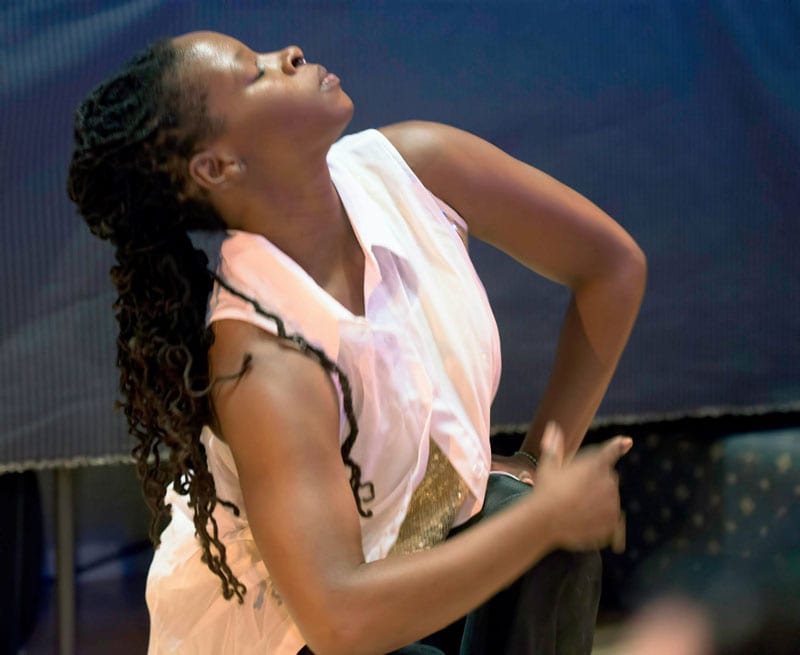Organizing Stories is a student-focused project founded and directed by Monica Huerta (English; American Studies) and Autumn Womack (English; African American Studies) and supported by an Exploratory Grant in Collaborative Humanities from the Humanities Council, as well as the Dean of the Faculty, the University Center for Human Values, the Department of African American Studies, and the Princeton African Humanities Colloquium. The final workshop of the academic year will host multidisciplinary artist and social justice advocate Indrani Pal-Chaudhuri on Friday, April 23 at 4.30pm.
Faculty and students in attendance at the most recent meeting of Organizing Stories were gifted with a powerful and personal experience led by artist and organizer Ni’ja Whitson. Autumn Womack, co-director and Assistant Professor of English and African American Studies, introduced Whitson and described how “from the moment I encountered their work, I was not only excited but also energized” and the inspiration she drew from Whitson’s model of “always living toward a different kind of world-making.” Whitson, who studies and practices indigenous African rituals and resistance forms, led participants through an interactive ritual that utterly transformed what might have otherwise felt like a typical hour on zoom. As Monica Huerta, co-director of the program and Assistant Professor of English and American Studies, reflected at the end of the workshop “My soul feels restored in a way that I didn’t know I needed and wouldn’t have known.”
Whitson prefaced the movement workshop with an explanation of the concepts and philosophies that influence their artistic and activist practice. The first concept links astrophysics with the “dark time that we’re engaging with,” connecting the scientific subjects of dark matter and dark energy, biomarkers, and escape velocity. “Ninety-five percent of all of the material in the universe we can’t see. It has been noted as dark because it doesn’t interact with light but it interacts with gravity,” explains Whitson, “For me, there is an easy metaphor between Blackness and dark matter as a profound impact on cosmology that is underacknowledged, invisibilized, but powerful.”
Whitson finds it equally important to think about biomarkers, or the technological, anthropological, human imprints that we leave on our environments; “I want us to be thinking about the ways in which what we emit is not just chemical and atmospheric, but also energetic and spiritual.” The final concept key to their work is the idea of escape velocity or the speed a planet would have to attain to leave its orbit. As Whitson explains it, the idea “feels incredibly liberatory to me. When we maintain a certain velocity, we can call that the status quo, or white supremacy. What is the speed at which we escape?”
With this explanatory background, Whitson guided participants through a ritual that they have been practicing most recently as part of a project that combines “embodied archival practice as well as embodied spirit work” in traveling to sites in the United States where a trans person of color has been murdered and protecting those spaces from further violence. As Whitson explained while inviting participants to walk outside, the root of the ritual lies in connecting with and becoming more attuned to the environments, grounding yourself in your surroundings, creating mindful intentions, and seeking permission to “do whatever the work is that you have committed to doing” in that space. In the minutes that followed, Whitson, faculty, and students used mobile devices as they ventured forth into their surroundings, steeping themselves in the scents, sounds, and energies of backyards in Massachusetts, city blocks in Philadelphia, fire escapes in New York City.
Participants were led through a series of movements that “use the body to compose a universe that is not yet or is to be”, and towards a closer awareness of the space they inhabit. Everyone was urged to consider: “What is your anthropogenic offering? What are the markers that you are leaving? With intentionality how can we shift that?”
As the workshop came to a close, Womack articulated what most participants were feeling as a result of going through the steps of Whitson’s practice: “We are all sitting with ourselves and our spaces in a new way that is really refreshing, dynamic, and energizing. It’s something I haven’t felt in the last year. I want to thank you for that.”
















